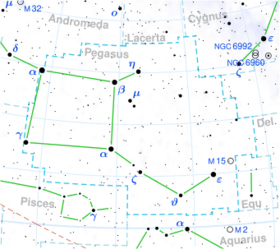Astronomy:1 Pegasi
| Observation data Equinox J2000.0]] (ICRS) | |
|---|---|
| Constellation | Pegasus |
| Right ascension | 21h 22m 05.199s[1] |
| Declination | 19° 48′ 16.24″[1] |
| Apparent magnitude (V) | 4.09[2] |
| Characteristics | |
| Spectral type | K1III[3] |
| U−B color index | +1.05[2] |
| B−V color index | +1.11[2] |
| Astrometry | |
| Radial velocity (Rv) | −10.80[4] km/s |
| Proper motion (μ) | RA: +105.35[1] mas/yr Dec.: +63.51[1] mas/yr |
| Parallax (π) | 20.93 ± 0.17[1] mas |
| Distance | 156 ± 1 ly (47.8 ± 0.4 pc) |
| Absolute magnitude (MV) | 0.68[5] |
| Details | |
| 1 Peg A | |
| Mass | 1.57[6] M☉ |
| Radius | 12[6] R☉ |
| Luminosity | 71.78[5] L☉ |
| Surface gravity (log g) | 2.59[7] cgs |
| Temperature | 4,600[8] K |
| Metallicity [Fe/H] | +0.01[7] dex |
| Rotational velocity (v sin i) | 1.2[9] km/s |
| Other designations | |
| Database references | |
| SIMBAD | data |
1 Pegasi (1 Peg) is a triple star[11] system in the constellation Pegasus, located approximately 156 light years away from the Sun based on parallax.[1] It is visible to the naked eye as a faint, orange-hued star with an apparent visual magnitude of 4.09.[2] The system is moving closer to the Earth with a heliocentric radial velocity of −11 km/s.[4]
The primary component is a giant with a stellar classification of K1III,[3] a star that has exhausted the hydrogen supply at its core and evolved away from the main sequence. It has 1.57[6] times the mass of the Sun and has expanded to 12[6] times the Sun's radius. The star is radiating 72[5] times the Sun's luminosity from its enlarged photosphere at an effective temperature of 4,600 K.[8]
There are several companions in addition to the primary. The brightest, component B, is a magnitude 9.3, K-type main-sequence star with a class of K0 V orbiting at an angular separation of 36.6" from the primary; it is itself a single-lined spectroscopic binary with an orbital period of 3.042 ± 0.011 years and eccentricity of 0.290±0.022.[12] Visual companions C, with magnitude 12.9 and separation 64.7", and D, with magnitude 9.6 and separation 5.3", have been reported.[13]
References
- ↑ 1.0 1.1 1.2 1.3 1.4 1.5 Van Leeuwen, F. (2007). "Validation of the new Hipparcos reduction". Astronomy and Astrophysics 474 (2): 653–664. doi:10.1051/0004-6361:20078357. Bibcode: 2007A&A...474..653V. Vizier catalog entry
- ↑ 2.0 2.1 2.2 2.3 Ducati, J. R. (2002). "VizieR Online Data Catalog: Catalogue of Stellar Photometry in Johnson's 11-color system". CDS/ADC Collection of Electronic Catalogues 2237. Bibcode: 2002yCat.2237....0D.
- ↑ 3.0 3.1 Hoffleit, D.; Warren, W. H. (1995). "VizieR Online Data Catalog: Bright Star Catalogue, 5th Revised Ed. (Hoffleit+, 1991)". VizieR On-line Data Catalog: V/50. Originally Published in: 1964BS....C......0H 5050. Bibcode: 1995yCat.5050....0H.
- ↑ 4.0 4.1 Bakos, G. A. (1974). "Radial velocity measurements of visual binaries. 1". The Astronomical Journal 79: 866. doi:10.1086/111622. Bibcode: 1974AJ.....79..866B.
- ↑ 5.0 5.1 5.2 Anderson, E.; Francis, Ch. (2012). "XHIP: An extended hipparcos compilation". Astronomy Letters 38 (5): 331. doi:10.1134/S1063773712050015. Bibcode: 2012AstL...38..331A. Vizier catalog entry
- ↑ 6.0 6.1 6.2 6.3 Allende Prieto, C.; Lambert, D. L. (1999). "Fundamental parameters of nearby stars from the comparison with evolutionary calculations: Masses, radii and effective temperatures". Astronomy and Astrophysics 352: 555–562. Bibcode: 1999A&A...352..555A. Vizier catalog entry
- ↑ 7.0 7.1 Wu, Yue; Singh, H. P.; Prugniel, P.; Gupta, R.; Koleva, M. (2010). "Coudé-feed stellar spectral library – atmospheric parameters". Astronomy & Astrophysics 525: A71. doi:10.1051/0004-6361/201015014. Bibcode: 2011A&A...525A..71W.
- ↑ 8.0 8.1 Gontcharov, G. A. (2009). "Red giant clump in the Tycho-2 catalogue". Astronomy Letters 34 (11): 785–796. doi:10.1134/S1063773708110078. Bibcode: 2008AstL...34..785G. Vizier catalog entry
- ↑ De Medeiros, J. R.; Mayor, M. (1999). "A catalog of rotational and radial velocities for evolved stars". Astronomy and Astrophysics Supplement Series 139 (3): 433. doi:10.1051/aas:1999401. Bibcode: 1999A&AS..139..433D. Vizier catalog entry
- ↑ "1 Peg". SIMBAD. Centre de données astronomiques de Strasbourg. http://simbad.u-strasbg.fr/simbad/sim-basic?Ident=1+Peg.
- ↑ Eggleton, P. P.; Tokovinin, A. A. (2008). "A catalogue of multiplicity among bright stellar systems". Monthly Notices of the Royal Astronomical Society 389 (2): 869. doi:10.1111/j.1365-2966.2008.13596.x. Bibcode: 2008MNRAS.389..869E. Vizier catalog entry
- ↑ Griffin, R. F. (February 1987). "Spectroscopic binary orbits from photoelectric radial velocities. Paper 72: 1 Pegasi B". The Observatory 107: 1–5. Bibcode: 1987Obs...107....1G.
- ↑ Mason, Brian D.; Wycoff, Gary L.; Hartkopf, William I.; Douglass, Geoffrey G.; Worley, Charles E. (2001). "The 2001 US Naval Observatory Double Star CD-ROM. I. The Washington Double Star Catalog". The Astronomical Journal 122 (6): 3466. doi:10.1086/323920. Bibcode: 2001AJ....122.3466M. Vizier catalog entry
 |


